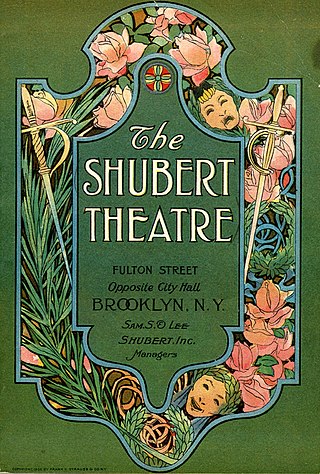
The Shubert Organization is a theatrical producing organization and a major owner of theatres based in Manhattan, New York City. It was founded by the three Shubert brothers in the late 19th century. They steadily expanded, owning many theaters in New York and across the United States. Since then it has gone through changes of ownership, but it is still a major theater chain.

The Belasco Theatre is a Broadway theater at 111 West 44th Street, between Seventh Avenue and Sixth Avenue, in the Theater District of Midtown Manhattan in New York City. Originally known as the Stuyvesant Theatre, it was built in 1907 and designed by architect George Keister for impresario David Belasco. The Belasco Theatre has 1,016 seats across three levels and has been operated by The Shubert Organization since 1948. Both the facade and interior of the theater are New York City landmarks.
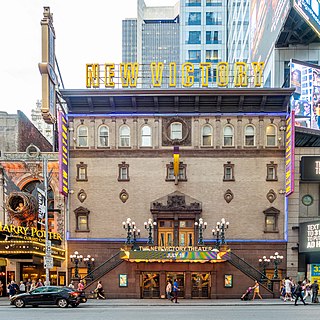
The New Victory Theater is a theater at 209 West 42nd Street in the Theater District of Midtown Manhattan in New York City, near Times Square. Built in 1900 as the Republic Theatre, it was designed by Albert Westover and developed by Oscar Hammerstein I as a Broadway theater. The theater has been known by several names over the years, including the Belasco Theatre, Minsky's Burlesque, and the Victory Theatre. The theater is owned by the city and state governments of New York and leased to nonprofit New 42nd Street, which has operated the venue as a children's theater since 1995. The New Victory presents theater shows, dance shows, puppet shows, and other types of performance art shows from all around the world.

Laura Nelson Hall was an actress in theater and vaudeville stock companies in the late 19th century and early 20th century.

Union Square Theatre was the name of two different theatres near Union Square, Manhattan, New York City. The first was a Broadway theatre that opened in 1870, was converted into a cinema in 1921 and closed in 1936. The second was an Off-Broadway theatre that opened in 1985 and closed in 2016.

The Fulton Theatre was a Broadway theatre located at 210 West 46th Street in Manhattan, New York City, that was opened in 1911. It was renamed the Helen Hayes Theatre in 1955. The theatre was demolished in 1982. After the former Little Theatre on 44th Street became the current Helen Hayes Theatre, the Fulton Theatre was sometimes referred to as the First Helen Hayes Theatre.
The Garden Theatre was a major theatre on Madison Avenue and 27th Street in New York City, New York. The theatre opened on September 27, 1890, and closed in 1925. Part of the second Madison Square Garden complex, the theatre presented Broadway plays for two decades and then, as high-end theatres moved uptown to the Times Square area, became a facility for German and Yiddish theatre, motion pictures, lectures, and meetings of trade and political groups.

The Music Master was a theatrical play written by Charles Klein, and produced and directed by David Belasco.

The Lyceum Theatre was a theatre in New York City located on Fourth Avenue between 23rd and 24th Streets in Manhattan. It was built in 1885 and operated until 1902, when it was torn down to make way for the Metropolitan Life Insurance Company Tower. It was replaced by a new Lyceum Theatre on 45th Street. For most of its existence, the theatre was home to Daniel Frohman's Lyceum Theatre Stock Company, which presented many important plays and actors of the day.

The Herald Square Theatre was a Broadway theatre in Manhattan, New York City, built in 1883 and closed in 1914. The site is now a highrise designed by H. Craig Severance.
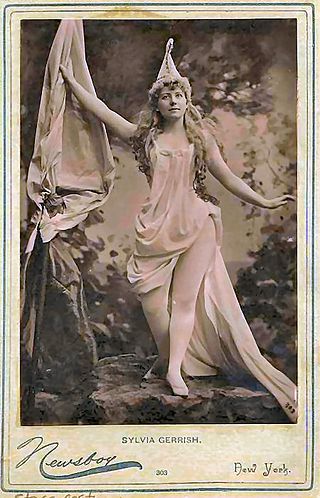
Sylvia Gerrish was an American musical theatre performer who found success in New York and London in the 1880s and early 1890s. She was known as "The Girl with the Poetical Legs".

The Empire Theatre in New York City was a prominent Broadway theatre in the first half of the twentieth century.

Laura Joyce Bell was an English-American actress and contralto singer mostly associated with Edwardian musical comedy and light opera.

Marie Jansen was an American musical theatre actress best known for her roles at the end of the 19th century. She starred in a number of successful comic operas, Edwardian musical comedies, and comic plays in New York, Boston, Philadelphia and London during the 1880s and 1890s.

Edward Siedle was an American property master and technical director who worked mainly at the Metropolitan Opera. During his tenure at The Met, he was directly in charge of all technical elements through one of its most innovative eras.
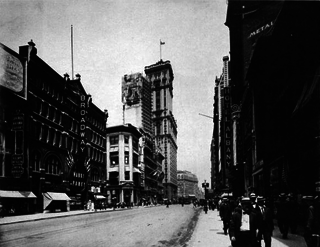
The Broadway Theatre near 41st Street was a Manhattan theatre in operation from 1888 to 1929. It was located at 1445 Broadway.
Max Freeman was a German actor, theater director, theater manager, playwright, and producer who was primarily active in the United States. After beginning his career in his native city of Berlin in 1868, Freeman eventually moved to the United States in 1871 where he began his career in America as the theatre manager for the Germania Theatre in New York City. He had a lengthy stage career as an actor in America from 1873 until his death in 1912. Known as the "godfather of comic opera", he particularly excelled in performances in roles from light operas and musical comedies, and was also responsible for directing and producing works from this genre on Broadway. He also directed and played parts in straight plays as well. His adaptation of Jacques Offenbach's Orfée aux enfers was performed for the grand opening of Broadway's Bijou Theatre in 1883, and his original musical play Claudius Nero, based on Ernest Erkstein's novel Nero, premiered at Niblo's Garden in 1890.
Abbey's Park Theatre or Abbey's New Park Theatre was a playhouse at 932 Broadway and 22nd Street in what is now the Flatiron District of Manhattan in New York City. It opened as the New Park Theatre in 1874, and was in use until 1882 when it burned down and was never rebuilt as a theatre.
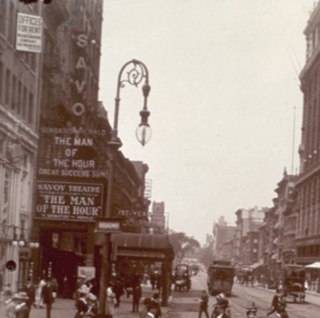
The Savoy Theatre was a Broadway theatre at 112 West 34th Street in Midtown Manhattan, New York City. It opened in 1900. It converted to a cinema around 1910, until it was closed in early 1952 and then demolished.

What Happened to Jones is an 1897 farce by George Broadhurst. It was his first successful play and remained popular for many years, and was also adapted into three silent films.



















